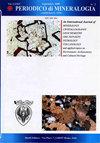最近在马达加斯加Anosy发现的常见绿色蛋白石的调查
IF 1.2
4区 地球科学
Q3 GEOCHEMISTRY & GEOPHYSICS
引用次数: 0
摘要
使用不同的分析方法,如标准光学和宝石学分析、X射线粉末衍射(XRPD)、扫描电子显微镜(SEM)、显微拉曼光谱和激光烧蚀微探针(LA-ICP-MS),研究了最近从Anosy(马达加斯加东南部)发现的常见绿乳的物理、化学和宝石论特性。Anosy蛋白石呈黄绿色,边缘浅黄色,半透明/不透明透明,有油腻光泽,有红色氧化斑点,对长短波长紫外线辐射(366–254 nm)呈惰性。折射率和比重的值分别在1.435-1.460和2.03-2.07之间。根据XRPD和拉曼分析,蛋白石为CT型,含比方石英更丰富的鳞石英,还含有粘土矿物(皂石)。铁,其次是V和Cu,是决定绿黄色的主要发色团,而Ni和Cr则非常次要。其他检测到的微量元素有Mg、Al、Ca、K和Na。Ba的高含量值得注意,因为这种元素在世界各地的蛋白石中很少被报道。SEM观察显示,在CT蛋白石中已经观察到三种类型的结构:均匀且非常细的微球、鳞翅目花椰菜结构和由薄片形成的不同大小的球状聚集体。本文章由计算机程序翻译,如有差异,请以英文原文为准。
Investigation of recently discovered common green opals from Anosy (Madagascar)
The physical, chemical and gemological properties of recently discovered common green opals from Anosy (South-Eastern Madagascar) have been investigated using different analytical methods such as standard optical and gemological analyzes, X-ray powder diffraction (XRPD), Scanning Electron Microscopy (SEM), Micro-Raman Spectroscopy and Laser Ablation Microprobe (LA-ICP-MS). Anosy opals have a yellowish green color with a light yellowish rim, translucent / opaque diaphaneity with greasy luster, red oxide spots and are inert to long and short wavelength UV radiation (366–254 nm). The values for refractive index and specific gravity range between 1.435–1.460 and 2.03-2.07, respectively. According to XRPD and Raman analyses, the opals are CT type with tridymite more abundant than cristobalite and also contain clay minerals (saponite). Iron and, subordinately, V and Cu appear the main chromophores that determine the green-yellowish color, while Ni and Cr are very subordinate. Other detected trace elements are Mg, Al, Ca, K, and Na. The high contents of Ba are noteworthy since this element is rarely reported in opals worldwide. SEM observations show three types of structures already observed in the CT opals: homogeneous and very fine microspheres, lepispheric cauliflower structures and globular aggregates of different sizes formed by laminae.
求助全文
通过发布文献求助,成功后即可免费获取论文全文。
去求助
来源期刊

Periodico Di Mineralogia
地学-地球化学与地球物理
CiteScore
1.50
自引率
14.30%
发文量
0
审稿时长
>12 weeks
期刊介绍:
Periodico di Mineralogia is an international peer-reviewed Open Access journal publishing Research Articles, Letters and Reviews in Mineralogy, Crystallography, Geochemistry, Ore Deposits, Petrology, Volcanology and applied topics on Environment, Archaeometry and Cultural Heritage. The journal aims at encouraging scientists to publish their experimental and theoretical results in as much detail as possible. Accordingly, there is no restriction on article length. Additional data may be hosted on the web sites as Supplementary Information. The journal does not have article submission and processing charges. Colour is free of charges both on line and printed and no Open Access fees are requested. Short publication time is assured.
Periodico di Mineralogia is property of Sapienza Università di Roma and is published, both online and printed, three times a year.
 求助内容:
求助内容: 应助结果提醒方式:
应助结果提醒方式:


